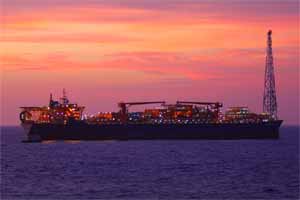In what spells trouble for gas-starved fertiliser and power sectors, the production of gas at the once-prolific Krishna-Godavari (KG) D6 block, held by Reliance Industries (RIL) along with partners BP and Niko Resources, is unlikely to pick up for the next four years at least. Rather, there is a fear that block’s output may fall 3% every month, a scenario the explorers are believed to to be trying to salvage. “There are no expectations of increase in (KG-D6) output before 2018-19. The contractor has rather said that there are signs of a decline to the tune of 3% every month, which they seem able to arrest and maintain an average output of 11-12 mmscmd (million metric standard cubic metres per day),” a senior petroleum ministry official told FE.
The KG-D6 gross production averaged 11.5 mmscmd during January-March 2015 against 11.8 mmscmd during October-December 2014. Post the commissioning of two booster compressor pumps, RIL is trying to revive some wells so as to maintain the production. In addition, after completion of appraisal wells in MJ-1, reservoir modelling and engineering is under progress, say analysts.
The KG-D6 fields began production in April 2009 and touched a peak of 69.43 mmscmd in March 2010.
Analysts are of the view that RIL and its partners are not willing to augment spending in the KG-D6 block as the current gas price of $5.18 per million British thermal units is not remunerative. Also, the explorers are entangled in arbitration with the government over cost-recovery from the block. The government has held the contractor responsible for falling gas output from the block. Meanwhile, state-run ONGC has also accused RIL of stealing about 18 billion cubic metres of gas between 2009 and September 2013 from its block KG-DWN-98/2, which lies next to KG-D6.
“RIL will try to maintain KG-D6 production levels (currently at around 11.5mmscmd),” said Harshad Borawake, an analyst at Motilal Oswal, adding, “It awaits arbitration clarity before embarking on new capex, which will delay production ramp-up.”
The news assumes significance at a time when the Narendra Modi government is desperately trying to infuse new life into the power sector where investments of over Rs 60,000 crore are on the verge of becoming NPAs due to non-availability of gas.
In March, the Cabinet Committee of Economic Affairs put in place a mechanism to import gas for stranded gas-based power plants and offer budgetary support to save them from becoming NPAs. Similarly, the government has decided decided to supply gas at uniform price to all fertiliser plants on the gas grid through a pooling mechanism.
During January-March 2015, RIL’s revenues from oil and gas segment dropped by 10.2% year-on-year to Rs 2,513 crore against Rs 2,798 crore in the same period a year earlier.
“E&P (exploration and production) segment remained weak due to sharp price declines and also lower volumes,” said Anil Sharma and Ravi Adukia, research analysts at Nomura.
RIL in a recent presentation to investors has said that it has commissioned two onshore terminal booster compressor units in the fourth quarter of FY15. These are expected to extend the life of the wells/recovery from the wells and offers opportunity to revive ceased wells that were shut in due to high water influx.
For Updates Check Company News; follow us on Facebook and Twitter


